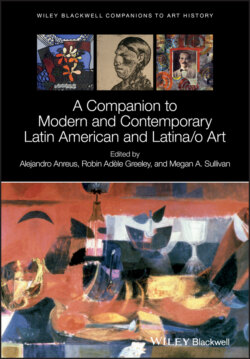Читать книгу A Companion to Modern and Contemporary Latin American and Latina/o Art - Группа авторов - Страница 2
Table of Contents
Оглавление1 Cover
2 Series Page
3 Title Page
4 Copyright Page
5 List of Illustrations
6 About the Editors
7 Notes on Contributors
8 Series Editor's Preface
9 Introduction References
10 Part I: 1910–1945 1 Art After the Mexican Revolution 1.1 Introduction 1.2 Mural Painting 1.3 Prints 1.4 Photography 1.5 Conclusion References 2 The Reinvention of the “Semana de Arte Moderna” 2.1 1922 2.2 1932 2.3 1942 2.4 1952 and After References 3 José Carlos Mariátegui and the Eternal Dawn of Revolution 3.1 Epoch and Revolution 3.2 Socialism, Indigenism, and the Nation 3.3 Conclusion: Mariátegui, His Times and Beyond References 4 National Values References 5 Photography, Avant‐Garde, and Modernity 5.1 A Violent and Expansive Medium 5.2 The Gender of Modernity9 5.3 Picturing Other, Picturing Self 5.4 Errant Europe References Further Reading
11 Part II: 1945–1959 6 Wifredo Lam, Aimé Césaire, Eugenio Granell, André Breton References 7 The Oscillation Between Myth and Criticism 7.1 The Ancient Modern (1950) 7.2 Mexican But Universal 7.3 Duchamp and Analogy: The Criticism of Things References 8 Latin American Abstraction (1934–1969) 8.1 Uruguay, 1935–1938 8.2 Argentina, 1945–1949 8.3 Argentina, 1955; Brazil, 1949–1957 8.4 Venezuela, 1955–1968 8.5 Venezuela, 1969; Brazil, 1959–1967 References 9 Architectural Modernism and Its Discontents 9.1 Modern Tropicality: The Brazilian Pavilion in New York, 1939–1940 9.2 Back to the South: Cities, Politics, and Nature Notes References Further Reading 10 The Realism‐Abstraction Debate in Latin America 10.1 The Question of the People 10.2 The Question of Autonomy 10.3 The Question of Efficacy 10.4 The Question of the Individual 10.5 Conclusion References 11 São Paulo and Other Models 11.1 São Paulo, 1951: In the Mold of Venice? 11.2 The BSP and Latin America 11.3 From São Paulo to Havana via Medellín 11.4 Conclusion: Forever an Artistic Center That Is Everywhere Known References
12 Part III: 1959–1973 12 Art and the Cuban Revolution 12.1 Introduction 12.2 The 1950s 12.3 An Early Conflict 12.4 Marxisms 12.5 A Brief Utopic Moment 12.6 Three Case Studies 12.7 Conclusion References 13 The Myths of Hélio Oiticica References 14 Between Chaos and the Furnaces 14.1 Figuration, Destruction, and the Image 14.2 Ghost Messages 14.3 An Art of Signifieds 14.4 Systems and New Images References 15 Chicana/o Art 15.1 Introduction 15.2 Al principio … 15.3 Chicano Art in the Community 15.4 Conclusion References 16 Cold War Intellectual Networks 16.1 Introduction 16.2 Southern Networks 16.3 Inter‐American Networks 16.4 Resisting Networks 16.5 Conclusion References Further Reading 17 José Gómez Sicre and the Inter‐American Exhibitions of the Pan American Union 17.1 Introduction 17.2 José Gómez Sicre's Curatorial Values 17.3 Early Inter‐American Exhibitions at the PAU 17.4 The Alliance for Progress Years 17.5 The Legacies of the PAU Inter‐American Exhibitions References 18 “… A Place for Us” References
13 Part IV: 1973–1990 19 An “Other” Possible Revolution 19.1 Idea as Art 19.2 Art as Attitude 19.3 Attitude as Revolution 19.4 Interruptions References Further Reading 20 Art in Chile After 1973 20.1 The Dominant Theory: The Avant‐Garde and Modernization 20.2 Utopian Modernisms, Traumatic Modernisms References Further Reading 21 Cold War Conceptualism 21.1 A New Aesthetics for 1968 21.2 Collectivity – A Conceptualist Aesthetico‐Politics 21.3 Cold War Conceptualism: Three Models 21.3a TAI's Althusserian Aesthetics of Ideology Critique 21.3b No‐Grupo and “Non‐objectualism” 21.3c Grupo Proceso Pentágono 21.4 Conclusion References Further Reading 22 Asco in Three Acts 22.1 Act I: Present Asco 22.2 Act II: Past Asco 22.3 Act III: Future Asco 22.4 Coda: Out of Time References 23 A Real Existence References
14 Part V: 1990–2010 24 Border Art 24.1 Introduction 24.2 Performative Protest: End of the Line 24.3 Allora and Calzadilla's Interventions in Vieques 24.4 Standing Still: Candiani's Battleground 24.5 Conclusion References 25 Walking with the Devil: Art, Culture, and Internationalization 26 Is This What Democracy Looks Like? Tania Bruguera and the Politics of Performance 26.1 Coda References 27 Shadows of the Doubtful Straight 27.1 Symbolic Possibilities: Gender and the Body 27.2 Object as Symbol and Vessel 27.3 Form as Expression 27.4 Conceptual Visions 27.5 Location, Space, and the Built Environment References Further Reading 28 Notes on the Dominican Diaspora in the United States 28.1 Introduction 28.2 Dominican Americans and Dominican American Art 28.3 Early Figures 28.4 Deeper Roots 28.5 Imagining Migration 28.6 Rethinking Race 28.7 Dominican American Art References 29 Antigonismos References 30 Art, Memory, and Human Rights in Argentina 30.1 Images That Were Present/Absent During the Years of Violence (1976–1983) 30.2 Portraits of the Disappeared and Memory of the Dictatorship 30.3 The Museography of Memory 30.4 Remembrance or Memorial Art References Further Reading
15 Part VI: Approaches, Debates, and Methodologies 31 Time and Place 31.1 The Time of the Nation 31.2 The Time of Internationalism 31.3 The Time of Contemporaneity References Further Reading 32 Is There Such a Thing as Latina/o Art? 32.1 Latina/o Art as Exhibition History 32.2 Latina/o Art as Practice 32.3 Latina/o Art as Critical Discourse References 33 The Expansion of Culture 33.1 Museums and Tourism 33.2 Sharing Patrimonies 33.3 What to Do with the Disinterested Public References Further Reading 34 A Question 34.1 Túkule's Bracelet 34.2 The Art of Others 34.3 Indigenous Art in Paraguay: Common Notes and Different Styles 35 What Is “Latin American Art” Today? References
16 Index
17 End User License Agreement
